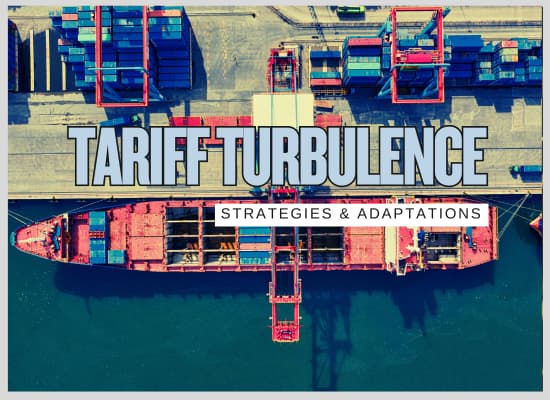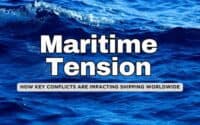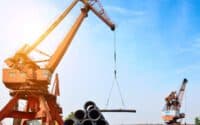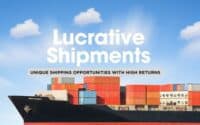Shadow Routes & Tariff Tactics: How Global Shipping Patterns Are Quietly Changing

Tariffs are no longer just policy headlines — they’re actively reshaping routing patterns, shipping demand, and how trade flows through the global maritime system. In response, some companies are pursuing legal — and occasionally questionable — strategies to minimize costs, while shipowners, ports, and logistics providers work to adapt.
This report explores the emerging trends, rerouting behaviors, and regulatory tensions shaping global trade in 2025. It does not provide legal advice or endorse any particular strategy. Instead, we present a neutral, factual overview of practices, enforcement developments, and the broader implications for maritime stakeholders.

We welcome your feedback, suggestions, corrections, and ideas for enhancements. Please click here to get in touch.
As tariff policies evolve and trade tensions escalate, global cargo flows are undergoing subtle but meaningful shifts. One emerging trend in 2025 is the rise of so-called “shadow routes” — indirect shipping paths used to navigate complex customs regimes. While not inherently unlawful, these routing decisions are often designed to leverage trade frameworks, reduce tax burdens, or avoid direct exposure to specific tariffs.
🌍 What Are Shadow Routes?- Indirect trade paths that route cargo through third countries or neutral ports before final delivery.
- May include repackaging, relabeling, or minor processing to align with preferential trade terms.
- Sometimes used to take advantage of free trade agreements or duty thresholds in destination markets.
- Increased tariffs on targeted goods like EVs, steel, and solar panels have made routing strategy more economically significant.
- Ongoing geopolitical friction is causing some shippers to re-evaluate exposure to bilateral trade disputes.
- Free trade zones and regional agreements are offering alternative pathways under different customs terms.
- Advanced trade tracking tools are making such strategies more visible to analysts and regulators alike.
- Transshipment via third countries with favorable trade access (e.g., China ➜ Mexico ➜ USA).
- Use of bonded warehouses for cargo restructuring prior to final import declaration.
- Final assembly or light processing in a secondary country to meet rules of origin criteria.
- Adjusting EU-linked voyage routes to mitigate exposure to carbon pricing under the EU ETS.
- Jebel Ali (UAE): Increasing transshipment volume between Asia and Europe.
- Manzanillo (Mexico): Seeing a rise in container flows from Asia headed toward North America.
- Laem Chabang (Thailand): Reported in investigations tied to auto parts routing.
- Port Klang (Malaysia): Identified in customs audits involving origin tracing.
- Many routing strategies are lawful when fully disclosed and compliant with trade agreements.
- Misrepresenting country of origin, undervaluing goods, or altering documentation crosses into regulatory violation.
- Customs authorities in the U.S., EU, and elsewhere are increasing enforcement and scrutiny of trade routes and declarations.
- Routing changes can affect charter demand, port congestion, and insurance exposure — all of which are relevant to stakeholders across the maritime value chain.
- Market observers note that many ports gaining traffic in 2025 are doing so not from raw volume growth, but from cargo rerouted to minimize exposure to duties or policy risk.
- Ongoing investigations suggest that increased transparency and digital customs systems may narrow the viability of some practices over time.
The growth of “shadow routes” reflects how global trade continues to adapt to tariff realignment and shifting compliance frameworks. For maritime stakeholders, these developments underscore the importance of route visibility, regulatory awareness, and evolving port dynamics — especially in transshipment and customs-sensitive regions.
The following examples provide additional context behind several routing workarounds that have been cited in trade analysis, customs investigations, or media reporting. These routes are not necessarily unlawful, but may involve documentation, processing, or transshipment strategies that impact tariff liability. The effectiveness and legality of such practices depend heavily on specific compliance with trade agreements, country-of-origin rules, and customs declarations.
🇨🇳 China → 🇲🇽 Mexico → 🇺🇸 United States- What’s Reported: Goods originating in China are shipped to Mexico, then transported into the U.S. under USMCA terms if origin requirements are satisfied.
- Objective: To take advantage of regional trade agreements while avoiding direct China–U.S. tariff lines.
- Observed Risk: Medium — U.S. Customs and Border Protection (CBP) has increased scrutiny on country-of-origin labeling and manufacturing activity to ensure USMCA compliance.
- What’s Reported: Several investigations have examined whether Chinese-made auto parts are being transshipped through Thai ports without substantial transformation.
- Objective: To obscure direct Chinese origin and potentially qualify for lower duty treatment.
- Observed Risk: High — U.S. lawmakers and customs authorities have actively probed such activity; outcomes are pending in some cases.
- What’s Observed: Use of Jebel Ali as a transshipment or repackaging hub for Asia-to-Europe cargo, particularly for electronics and machinery.
- Objective: To facilitate lower-profile customs routing or modify shipment packaging before EU entry.
- Observed Risk: Medium — While legal transshipment is common, origin declaration compliance remains critical under EU rules.
- What’s Cited: Trade monitoring services have noted growth in cargo volume flowing through Port Klang (Malaysia) en route to the U.S., especially for apparel and consumer electronics.
- Objective: To leverage existing FTA structures or avoid country-specific duties.
- Observed Risk: Medium–High — Documentation standards and chain-of-custody verification are becoming a key focus for U.S. enforcement agencies.
- What’s Reported: Cargo routed through Busan, Korea, to the U.S. under the assumption that Korean assembly or value-addition meets origin thresholds under KORUS.
- Objective: To qualify for reduced duties under U.S.–Korea trade agreements.
- Observed Risk: Medium — Legal when compliant, but authorities have emphasized the importance of clear transformation steps and documentation.
⚖️ Disclaimer: This section is for informational purposes only. It does not constitute legal advice, nor does it endorse or recommend any particular customs routing or declaration method. The legality and acceptability of trade routing strategies depend entirely on the facts of each case, local laws, international agreements, and applicable customs regulations. For compliance questions, consult a licensed trade attorney or customs broker.
🔍 Tariff Loopholes vs. Tariff Violations
As global trade routes evolve under the pressure of tariffs and protectionist policies, some companies pursue legal structures and trade agreement strategies to reduce costs. Others may cross into territory that draws legal or regulatory scrutiny. In this section, we explore the difference between recognized trade tactics — such as bonded warehousing or free trade zone use — and what customs authorities consider misrepresentation or violation. The boundary between compliance and risk is often nuanced, and it's shaped by documentation, intent, and jurisdiction.
The difference between lawful duty mitigation and actionable tariff violations often lies in execution and transparency. Below are commonly cited practices in maritime trade and how they may be perceived depending on how they’re applied and declared.
✅ Common Legal Tariff Management Strategies:- Use of Free Trade Agreements (FTAs): Leveraging bilateral or multilateral trade deals when origin rules are satisfied.
- Bonded Warehousing: Storing goods without triggering import duties until final delivery is declared.
- Transshipment: Routing cargo through intermediate countries, provided documentation is accurate and compliant.
- First Sale Rule: In some jurisdictions, declaring the value of the first transaction in a multi-party chain (e.g., U.S. under strict documentation rules).
- Mislabeling Country of Origin: Declaring a false origin to avoid tariffs or meet trade agreement thresholds.
- Falsifying Commercial Invoices or Declarations: Understating value, manipulating classification codes (HS Codes), or using false paperwork.
- Insufficient Transformation in Transshipment: Routing goods through third countries without substantial change to claim new origin status.
- Clear proof of origin, including manufacturing, assembly, or transformation evidence.
- Invoice consistency, shipping logs, and chain-of-custody documentation.
- Patterns that indicate artificial structuring or avoidance behavior.
Many trade optimization strategies are legal — when fully disclosed, documented, and structured in line with applicable rules. However, when documentation is incomplete or misleading, the same practices may be reclassified as tariff evasion. Global enforcement is evolving quickly, with new tools and audit programs expanding across jurisdictions.
⚖️ Disclaimer: This content is for informational purposes only and does not constitute legal or customs compliance advice. The legality of any trade practice depends on local laws, bilateral agreements, and the specific facts of each transaction. For questions regarding tariff exposure or compliance, consult a licensed customs attorney or trade compliance professional.
Impact on Global Ports & Shipowners
The effects of tariff-driven route changes and regulatory developments are not limited to supply chains — they’re being felt at the port level and across the shipping sector. Some ports are seeing increased traffic due to shifting trade corridors, while others are experiencing a slowdown. For shipowners, these shifts may affect fleet utilization, charter strategy, and port selection. The following table highlights observed trends supported by public trade data and independent industry coverage.
As shipping patterns shift in response to tariffs and regulatory changes, customs authorities around the world are stepping up enforcement. These actions are not limited to headline-grabbing investigations — they include enhanced documentation checks, technology-driven audits, and new reporting rules designed to increase transparency throughout global trade.
📌 Key Areas of Increased Scrutiny:- Country of Origin Claims: Customs authorities are placing greater emphasis on verifying that declared origin aligns with manufacturing or substantial transformation records.
- Transshipment Monitoring: Shipments routed through third countries may receive added attention, particularly if origin documentation is incomplete or inconsistent.
- De Minimis Threshold Abuse: In the U.S., growing concern over small-parcel duty exemptions has led to proposed reforms and active review of fast fashion and electronics importers.
- Misclassification and Undervaluation: Investigators continue to flag cases where goods are declared under incorrect HS codes or values are understated to reduce duty exposure.
- U.S. CBP Investigations: Ongoing reviews into parts, electronics, and apparel routing practices, particularly where transshipment is used to obscure origin.
- EU Enforcement Tools: The EU is investing in customs digitalization and data-sharing platforms to better trace cargo origin and assess carbon compliance under new ETS requirements.
- ASEAN Member Activity: Some Southeast Asian nations have strengthened documentation requirements to prevent being used as unintended conduits for tariff avoidance.
- AI and machine learning are being deployed to flag shipment anomalies, irregular port sequences, or inconsistent documentation patterns.
- Cross-border trade databases are improving cooperation between customs agencies in multiple jurisdictions.
- Shipowners and operators may face more frequent documentation reviews on certain trade lanes.
- Forwarders and NVOCCs are expected to provide clearer audit trails for multi-leg shipments.
- Ports associated with flagged routing patterns may see slower processing or additional customs interventions.
⚖️ Disclaimer: The content above is intended for general informational purposes only and does not constitute legal or compliance advice. Enforcement trends vary by jurisdiction and may change as new policies are introduced. Readers are advised to consult licensed customs or trade professionals for specific compliance questions.
Strategic Takeaways for Stakeholders
As trade enforcement tightens and shipping routes evolve, each player in the maritime logistics ecosystem is facing new questions. Shipowners must reconsider charter routes and exposure risks. Freight forwarders are adapting to tighter customs checks. Ports are competing for relevance in a shifting network. Investors are rebalancing exposure. The table below outlines how key stakeholders may be affected — and what strategic responses are being explored.
Global shipping is entering a new era — one shaped not only by fuel costs and capacity cycles, but by the growing complexity of trade policy, carbon pricing, and regulatory enforcement. For shipowners, port operators, forwarders, and maritime investors alike, understanding how tariffs and compliance dynamics influence routing, profitability, and risk exposure is no longer optional — it’s operationally essential.
This report has aimed to present a fact-based overview of how tariff pressures are reshaping global cargo flows, enforcement patterns, and port activity. While some routing trends raise regulatory questions, many reflect the broader reality of supply chain adaptation in an increasingly fragmented global trade environment.
Staying informed, investing in transparent logistics systems, and building flexibility into fleet, routing, and compliance decisions will remain key strategies in 2025 and beyond.
Table Summary

Do you have a Maritime Product or Service that may be of interest to Shipowners? Tell us about it here!
Do you have feedback or insights? Please reach out to editor @ shipuniverse.com



